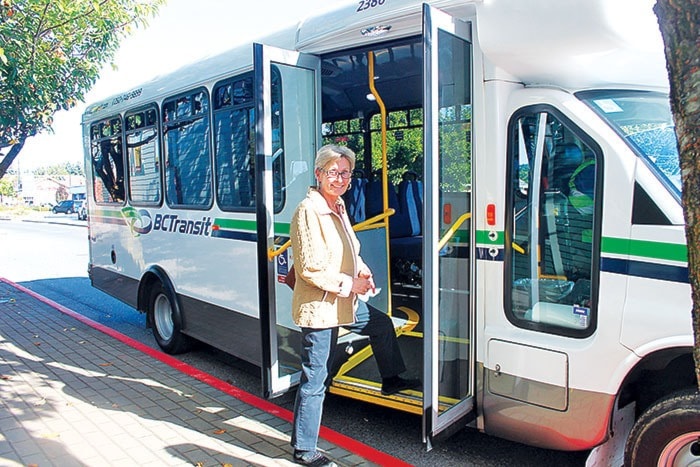It’s been a bit of a bumpy ride, but the regional transit service is beginning to gain traction in Ladysmith.
“The estimates from staff is that for the Ladysmith routes we had something like in excess of 10,000 people use the transit system,” said Ladysmith Mayor Rob Hutchins, who also chairs the Cowichan Valley Regional District Board. “It’s not as large a number as we expected, but it is not unusual in the first year of a new service that it takes a while.”
The regional district and BC Transit introduced the Ladysmith service last September, with four local routes as well as a connector to Chemainus.
“The biggest complaints or concerns was that the timing points were a bit too tight if you were doing a transfer, especially to Chemainus,” said BC Transit spokesperson Meribeth Burton, adding some tweaks were made to the routes in May.
“In transit speak, we’ve loosened up some of those timing points and given both our operators and passengers a little bit more leeway to make those pivotal connections and the response has been positive since.”
Hutchins said the Ladysmith-Chemainus connector has proven to be the most popular of the new routes, with an estimated 3,000-plus riders over the first year.
One of those riders is Sue Ferguson, who takes the bus to Chemainus three times a week to work at the thrift store as a volunteer with the hospital auxiliary.
“I love it. I wish there were more trips,” said Ferguson, who retired to Ladysmith just after the service was introduced last September.
“It’s a good little service, especially in the morning because you have the connector for Duncan,” said Ferguson, who also uses the local service. “Without it I’d be up the creek, I’d be doing a lot of walking.”
Another resident who depends on the Ladysmith service is Zurona Nelson.
“It’s a good system. I use it quite a bit actually, to go out to Coronation and up the hill so I don’t have to walk,” said Nelson, adding she’s noticed more people using transit as the year’s gone by but ridership remains sporadic.
“It goes to Chemainus and Duncan, which is nice because you can get to a bigger town to do the things you need to do,” said Nelson as she waited at the bus stop with eight-year-old daughter Jazsea. “It goes to Duncan but it doesn’t go to Nanaimo, which is weird because there’s so much that people in Ladysmith go to Nanaimo for. It’s great that you can take the Greyhound but it only comes once a day and comes back once a day so you’re stuck in Nanaimo for the day.”
Hutchins said a connection with Nanaimo is one of the things the CVRD is working on.
“There’s still a pent-up desire to make a connection to Nanaimo but that takes planning by both regional districts to make that happen. I know staff are meeting and looking at options.”
Hutchins said the connection to the south had to be established first to complete the link with the Cowichan Valley region. He said a lot of work remains to be done before a link to Nanaimo is ready, with CVRD staff having to work with their counterparts in the Nanaimo Regional District to iron out details such as where the two routes would meet.
“One of the proposals being considered is perhaps making connections between the CVRD and the Nanaimo Regional District at the airport,” said Hutchins.
One new service Ladysmith residents can expect to see is the introduction of HandyDart, which will begin twice-a-week service to Ladysmith Oct. 6.
“We will be providing the service Tuesdays and Fridays. It was a matter of looking at distributing the time over the week and also fitting it in with the other communities that CVRD serves with HandyDart,” said Burton, adding the service has proven extremely popular everywhere it’s been introduced.
One of the biggest challenges faced by the new transit system is cost. BC Transit statistics compiled back in March showed an estimated cost of $49.33 per passenger trip.
“Like any business, it takes time to grow,” said Hutchins, adding transit represents an annual cost of about $40 for the average Ladysmith household, with that cost expected to rise slightly with the introduction of HandyDart.
“It needs to be evaluated on a regular basis, and if it’s proven that there isn’t a need for it then we have to take a look at it and see if we need to change the routes or change the hours to maximize the service to the community that needs it,” said Hutchins, adding the conventional routes could be trimmed to offset the cost of a potential future service to Nanaimo.
Of course, the simplest way to reduce the cost is to increase the number of riders. And that’s something that bus driver John McWilliam has seen steadily grow over the course of the past year.
“It’s a thing where people have to get used to it. Ladysmith has long been a town where people jump into their cars, even if it’s only two minutes, but it’ just getting so expensive,” said McWilliam.
Ladysmith riders will also notice a few local rate changes beginning in October. Adult fares will remain at $2, while the rates for students and seniors will jump to $2 from $1.75. A sheet of 10 adult tickets will jump $2 to $18, while students and seniors will see an increase from $13.50 to $15. Day passes will remain unchanged for adults, while they will jump to $4 for students and seniors from the current $3.25.
“The reason for the fare change on the conventional system is that, generally speaking, having one flat price limits fare disputes with operators so you don’t need to produce ID to prove age,” said Burton. “The reason monthly passes hasn’t changed is because we do like to encourage those long-term fare products.”
